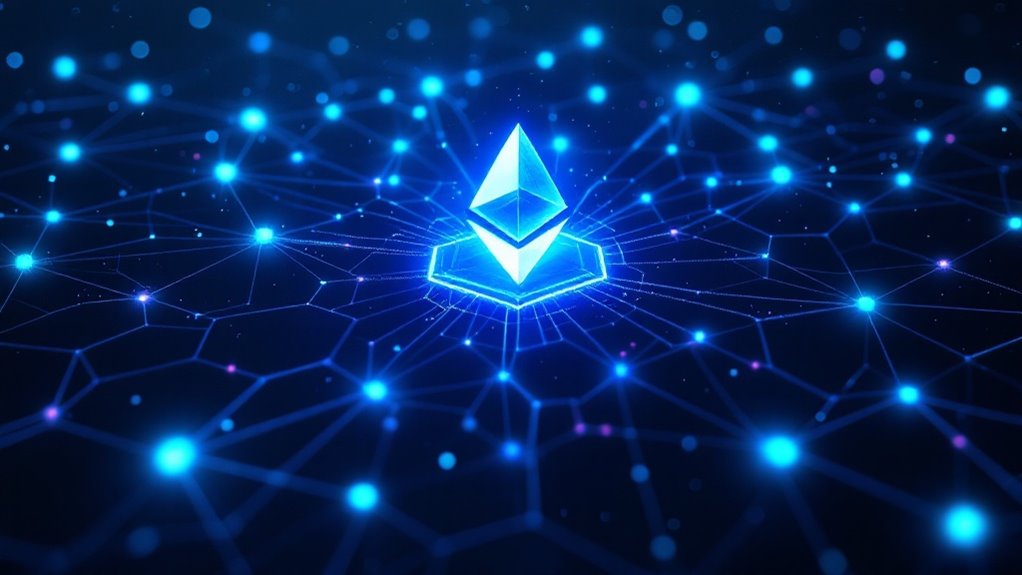Ethereum functions as a groundbreaking digital ecosystem where smart contracts automate agreements and transactions flow seamlessly through a vast network of computers. At its core, the Ethereum Virtual Machine processes calculations while charging "gas fees" to prevent spam. The network recently shifted to a more sustainable proof-of-stake system, where validators stake 32 ETH to maintain operations. This intricate dance of code, cryptocurrency, and consensus creates endless possibilities for reshaping our digital future.

Ethereum powers a digital revolution that extends far beyond simple cryptocurrency transactions. At its core lies an intricate network of computers working in perfect harmony, each maintaining an identical copy of a vast digital ledger. Like a living, breathing organism, this blockchain grows with every passing moment as new transactions and smart contracts pulse through its digital veins.
The heart of Ethereum beats through its smart contracts – sophisticated programs that execute automatically when specific conditions are met. Written in a language called Solidity, these digital agreements operate with unwavering precision, free from human intervention or manipulation. They're like tireless digital lawyers, working around the clock to enforce agreements without coffee breaks or billing hours. The platform serves as the foundation for decentralized finance applications, transforming traditional financial services. Once deployed, these contracts become completely immutable, ensuring unbreakable trust in their execution.
Smart contracts are Ethereum's digital sentinels, executing complex agreements with flawless precision while never needing rest or reward.
Behind the scenes, the Ethereum Virtual Machine (EVM) serves as the network's brain, processing countless calculations across a global network of nodes. This decentralized computer charges "gas fees" for its services, much like a meter running in a taxi, ensuring that computational resources are used efficiently and preventing network spam. The platform enables the creation of digital collectibles and unique tokenized assets.
The network recently underwent a remarkable transformation, shifting from energy-hungry mining to a more sustainable proof-of-stake system. Gone are the days of massive computer farms solving complex puzzles. Instead, validators now stake 32 ETH to participate, like responsible citizens posting bond to serve their digital community. This change has slashed energy consumption by an astounding 99.95%.
Every transaction in Ethereum's ecosystem involves a careful dance between two types of accounts: those controlled by human users with private keys, and those governed by smart contract code. These interactions update Ethereum's global state, creating a permanent record of digital history that's virtually impossible to alter or erase.
The native cryptocurrency, Ether (ETH), flows through this system like digital fuel, powering transactions and compensating validators for their service. As fees are burned after each transaction, ETH becomes increasingly scarce, adding another layer of economic complexity to this fascinating digital ecosystem.
Frequently Asked Questions
What Makes Ethereum Different From Other Blockchain Platforms?
Ethereum distinguishes itself through its programmable smart contracts, versatile EVM environment, efficient proof-of-stake consensus, and extensive ecosystem supporting DeFi, DAOs, NFTs, and tokenization of real-world assets, enabling diverse blockchain applications.
How Long Does It Take to Mine One Ethereum?
Prior to the 2022 Proof-of-Stake changeover, mining one Ethereum took approximately 27.6 days with a 2,500 MH/s hash rate. Currently, Ethereum can't be mined as it uses staking instead.
Can Ethereum Be Traced Back to Its Original Owner?
Ethereum transactions can be traced on the public blockchain through wallet addresses. However, while transactions are traceable, identifying the original owner depends on whether they've linked their identity to their wallet address.
Why Do Ethereum Gas Fees Fluctuate so Much?
Ethereum gas fees fluctuate due to network congestion, transaction complexity, and ETH price changes. High user demand during NFT drops, DeFi trading surges, and market volatility directly impacts fee levels.
Is There a Maximum Supply Cap for Ethereum?
Ethereum does not have a maximum supply cap, unlike Bitcoin's 21 million limit. The cryptocurrency has a dynamic supply that adjusts through issuance to validators and burning of transaction fees.









